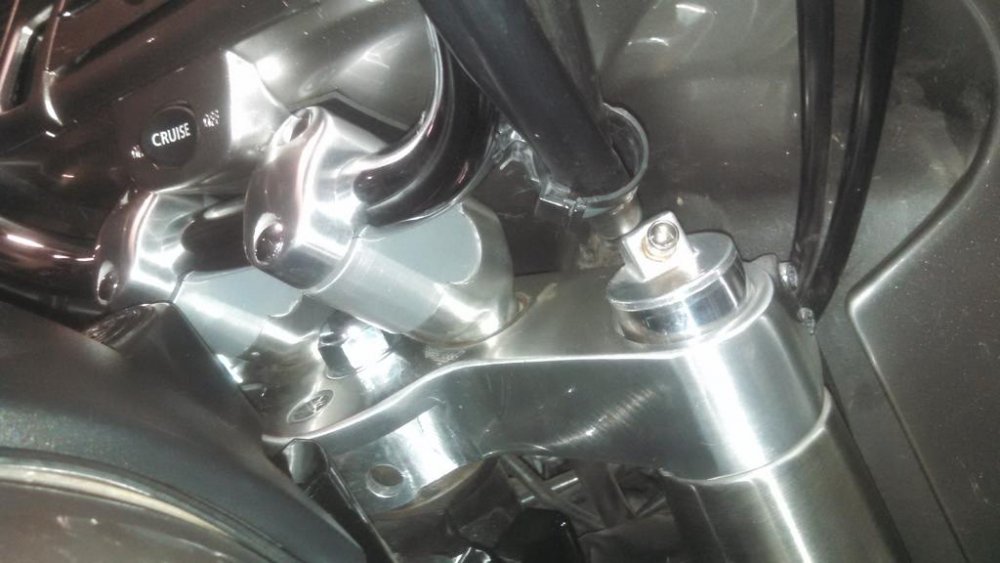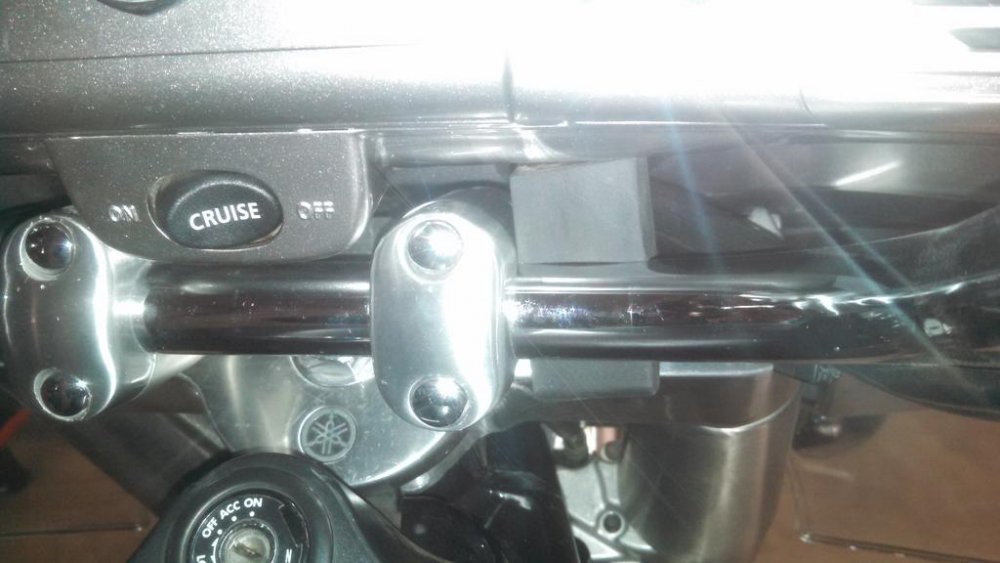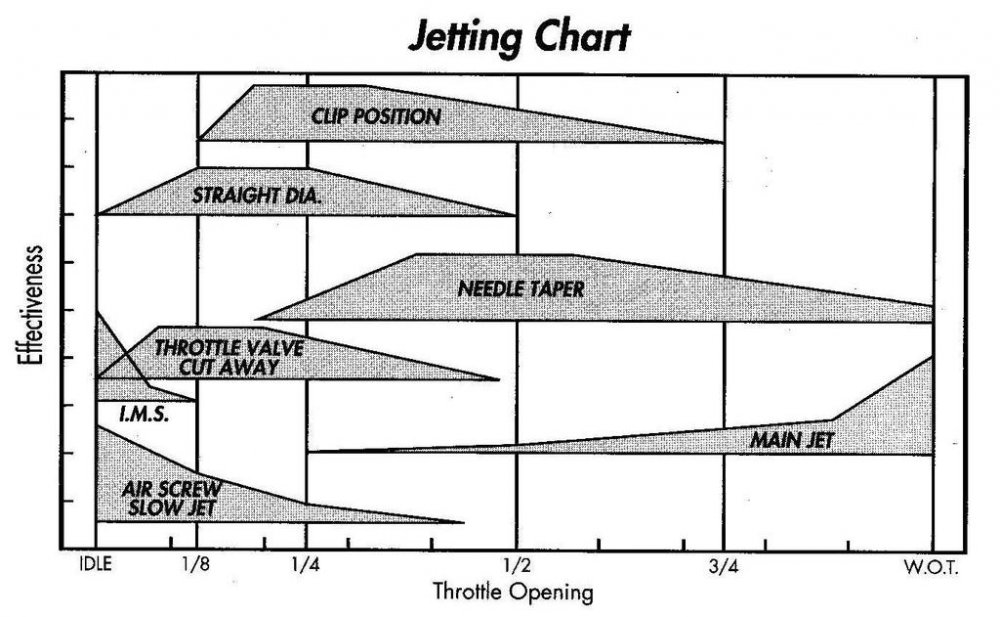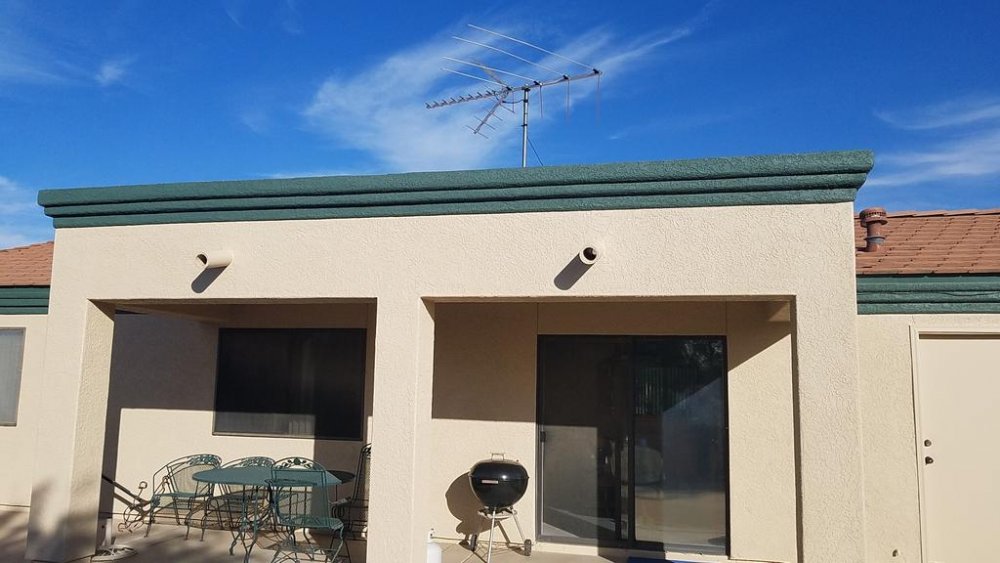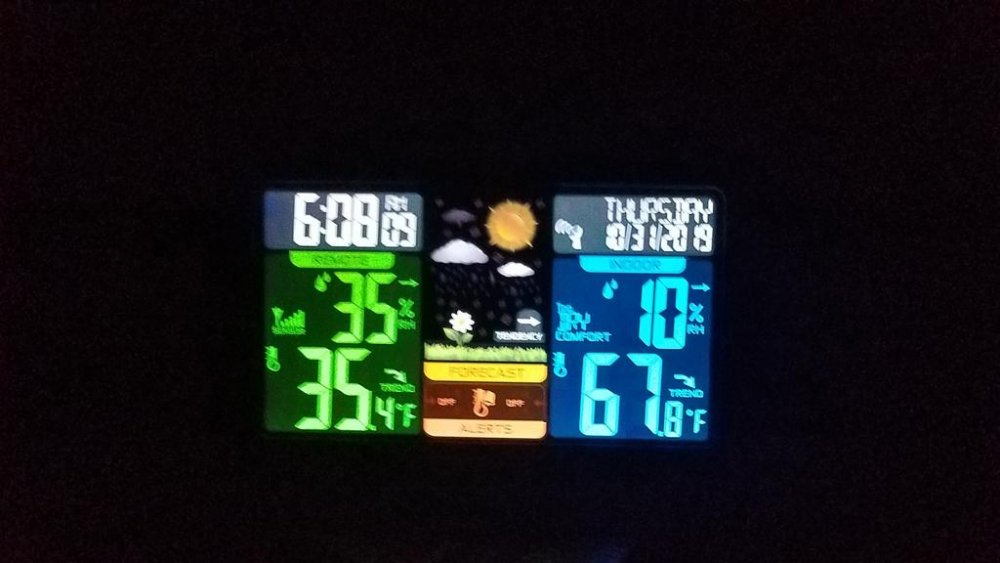-
Posts
4,225 -
Joined
-
Last visited
-
Days Won
13
Content Type
Profiles
Forums
Gallery
Events
Store
Everything posted by videoarizona
-
There is no way for the enrichning circuit to dump fuel. And with the tank below the carbs, no way the fuel from the tank can do that either. My feeling is you had a carb dump it's bowl after you shut her off. Stuck float.
-
You should have no troubles raising the shock tubes up 1 inch. Above picture is mine. And I have the bar extensions as well. No relocating the cables...just move them out of the way....everything fits.... BTW, I did go into the front inside fairing and raise it off the bolts a touch with a few washers....making the instrument panel sit more upright. Just enough to allow me to position the bars better for my arms...I raised the bars up... Then repositioned the rubber bumpers between the tree and the inside fairing as shown here....used rubber glue to hold them. Works great.
-

A memory patch for BongoBob for your vest.
videoarizona replied to Jayceesfolly's topic in Watering Hole
Got mine yesterday....thanks, Jim! -
Last time I saw that view...the grass was green with mist....hmmm...I do like the pic, though. Sorry Boss, but I do like winter, just don't like living in it any more! LOL!
-

New to me RSV, poor MPG
videoarizona replied to VaRider's topic in Royal Star Venture Tech Talk ('99 - '13)
-
Fyi...I close the petcock after every shutdown. With the tank higher than the carbs, gravity will push the fuel into the carbs if the float sticks. Good idea about the shut off. BTW, don't run that beautiful scoot like an HD. Let her rev. She'll pull 6k rpm without batting an eye... Welcome to the nuthouse!
-
-

Spark Plug question - Old School vs Iridium
videoarizona replied to bpate4home's topic in General Tech Talk
I would put this question in the Gen 3 section. Dave Wells and others have put some miles on their 3's and may have some observations about plugs. That said, Yea...I can't see any reason not to run iridiums in any performance motor. -

Spark Plug question - Old School vs Iridium
videoarizona replied to bpate4home's topic in General Tech Talk
I own both Generations and use iridiums in both......they are worth the few extra bux as far as I am concerned. I even used iridiums in my VStar 950 when I still had her. -
With this ear operation....all major activities are on hold until DOC gives me a thumbs up. So went over to both bikes today and patted them on their seats. They understood...
-

Spark Plug question - Old School vs Iridium
videoarizona replied to bpate4home's topic in General Tech Talk
Iridium is the best way to go. But still plan on changing them out every two to three years. Motorcycle V4 engines are a little different than an auto engine. These motors do tend to use up plugs faster. Still, iridium plugs are a cheap and easy maintenance item every couple of years... -

Not MC, but still looks like fun. My other passion.
videoarizona replied to Flyinfool's topic in Watering Hole
With those colors, will you be able to tell, spatially, how the aircraft is orientated??? I think I would have trouble. -
If you want reach, a good old UHF/VHF antenna can go up to 100miles, they say. I would say, no...maybe 80 miles max if you are above average terrain and don't have mountains in the way. Most of the really good ones will get you 50 to 60 miles. https://www.channelmaster.com/Digital_HDTV_Outdoor_TV_Antenna_p/cm-3016.htm Mine is the equivalent to the 60 mile unit. But it's about 25 years old. It sits on an 8 ft pole on the roof of the back patio (about 22ft above average terrain)...so it has to look through the roofline to see the mountain where Tucson's TV transmitters are. They are about 45 miles away....
-
I'm so glad to hear the good news! Long time coming... Now... Do your ole bod a favor and take it easy...ramp up slowly... And enjoy the Holidays this year!
-
Remember, the really big antenna will make a strong signal. So pick up 2 strong in-line attenuators... and try them too. Overloading the front end of your tuner won't give you a better picture.... You will get close, that I'm sure.
-

New to me RSV, poor MPG
videoarizona replied to VaRider's topic in Royal Star Venture Tech Talk ('99 - '13)
Good to hear. I've found my 05 RSV loves iridium plugs. They last about 2 years max. These V4's do like plugs...! -

New to me RSV, poor MPG
videoarizona replied to VaRider's topic in Royal Star Venture Tech Talk ('99 - '13)
The most important thing for poor mileage is usually the carbs. Either the air cleaners are dirty or the carbs are a bit gummed up due to sitting a lot. Let's face it, a low mileage bike like yours (congrats, by the way!) Can be problematic as it's not being run enough. Fuel system cleaner and ride it like you stole it. BTW, if this is your first experience with the Yamaha V4, know that if it doesn't have power on the highway, you are most likely in the wrong gear. You can ride all day long at speed limit in 4th gear...seriously. I've run that motor up to 85 in 3rd gear without it even being bothered. Both 4th and 5th are over drives...with most of us never even thinking of shifting into 5th until 65 to 70mph. The 2nd gen RSV you have...has about the lowest rpm limiter of the bunch. Around 6K rpm. Since the earlier generation motor (same motor) goes to 7500 rpm without issue, and the VMax version goes far higher than that....you aren't hurting anything by letting her rev. So...run some cleaner in the gas and ride like heck...stay in 3rd or 4th most of the time and let her rip. If that doesn't help, then you will need to clean the carbs. A time consuming but easy project...well documented in the tech section. Last thoughts...the coils and plug wires rarely have issues...so think fuel first to get the front cylinders working. And take the air intake system apart (pain in butt) but easy as well...cleaning everything as you go. -
Yep..I had a drive shaft failure on my 89. There were two types of failures in the drive shaft area, both caused (we think) by metal fatigue or improperly heated bolts/gears....etc.. The 1st involved the bolt that holds the ujoint on to the drive gear. This is on the front end of the drive shaft. The bolt shears off...leaving the bolt head to sit inside the ujoint. Nothing else happens as the ujoint can't go anywhere as it's captured by the drive shaft and still moves the bike as it's a splined joint. The 2nd was my failure. The bolt at the OTHER end of the drive shaft broke off. Again...the joint is captured by the shaft and continued to move the bike. My symptoms were a whine upon deceleration with a slight vibration. This doesn't sound like what you are experiencing at all. What it sounds like you are experiencing may be a bearing failure due to inadequate grease or simply the pins @cowpuc shows in the video are dry as a bone. If you take the wheel off and clean those pins and the inserts they sit in...then grease them up...your problem might be solved. The other issue is check the front wheel bearings. Sometimes these go bad from improper lubrication as well. The idea of tearing both the front and rear apart just for grins...is a good one. Because you need to know the condition of everything in the bike. Establishing a baseline of service makes it so much easier for you to keep tabs on what needs to be done. These bikes are serious long haulers. They will go for years without breakdown as long as a little bit of maintenance is done to them.
-

Stuck fuel cock on 89 Venture
videoarizona replied to mgdawson's topic in Venture and Venture Royale Tech Talk ('83 - '93)
Just leave it on reserve and don't worry. The tank is below the carbs so a leaky float won't hurt the engine. -
Jeff, Yes there is. The tuners of the Flintstone days did it by picking the strongest or earliest and filtering out the rest. The best of the analog tuners would pretty much eliminate ghosts. The NTSC TV system we have today is the worst choice of the 2 major competing signal formats. Much like the FCC chose NTSC as our TV format back in the days of wooden airplanes....so...they have chosen the wrong format twice! NTSC (Never The Same Color) was a ***** to make work...but good old US engineers got it worked out. Same holds true for the newer signal format, 8VSB. 8VSB was the worst at multipath rejection, ghosting (ad nauseum) proven in 2008 in every major metro area where it was tested. It's only virtue is it's ability to reach out and go long.... TV Tuners of today are now on their 8th or 9th generation of tuners(or more) and are just now beginning to work as well as the other competing signal format ()COFDM) would have worked on it's 1st generation. The ATSC signal format is really not good for the USA as the majority of it's population live in cities where multipath is the worst known problem and the major reason why cable TV got so much market penetration in cities. ++++++++++++++++++ 1: [/color]"While the ATSC system has been criticized as being complicated and expensive to implement and use,[13] both broadcasting and receiving equipment are now comparable in cost with that of DVB. The ATSC signal is more susceptible to changes in radio propagation conditions than DVB-T and ISDB-T. It also lacks true hierarchical modulation, which would allow the SDTV part of an HDTV signal (or the audio portion of a television program) to be received uninterrupted even in fringe areas where signal strength is low. For this reason, an additional modulation mode, enhanced-VSB (E-VSB) has been introduced, allowing for a similar benefit. In spite of ATSC's fixed transmission mode, it is still a robust signal under various conditions. 8VSB was chosen over COFDM in part because many areas are rural and have a much lower population density, thereby requiring larger transmitters and resulting in large fringe areas. In these areas, 8VSB was shown to perform better than other systems. COFDM is used in both DVB-T and ISDB-T, and for 1seg, as well as DVB-H and HD Radio in the United States. In metropolitan areas, where population density is highest, COFDM is said to be better at handling multipath propagation. While ATSC is also incapable of true single-frequency network (SFN) operation, the distributed transmission mode, using multiple synchronized on-channel transmitters, has been shown to improve reception under similar conditions. Thus, it may not require more spectrum allocation than DVB-T using SFNs. A comparison study found that ISDB-T and DVB-T performed similarly, and that both were outperformed by DVB-T2.[14]" ++++++++++++++++++++++++++++ 2: Disputes over ATSC's use[edit] For some period of time, there had been a continuing lobby for changing the modulation for ATSC to COFDM, the way DVB-T is transmitted in Europe, and ISDB-T in Japan. However, the FCC has always held that 8VSB is the better modulation for use in U.S. digital television broadcasting. In a 1999 report, the Commission found that 8VSB has better threshold or carrier-to-noise (C/N) performance, has a higher data rate capability, requires less transmitter power for equivalent coverage, and is more robust to impulse and phase noise.[2] As a result, it denied in 2000 a petition for rulemaking from Sinclair Broadcast Group requesting that broadcasters be allowed to choose between 8VSB or COFDM as is most appropriate for their area of coverage.[3] The FCC report also acknowledged that COFDM would "generally be expected to perform better in situations where there is dynamic multipath," such as mobile operation or in the presence of trees that are moving in high winds. However, with the introduction of 5th Generation demodulators in 2005 and subsequent improvements in generations 6 and 7, the equalization span is now about −60 to +75 microseconds (a 135 microsecond spread) and has virtually eliminated multipath, both static and dynamic, in 8VSB reception. In comparison, the equalization span in COFDM is −100 to +100 microseconds (200 microsecond spread), but the application of this much guard band space for COFDM substantially reduces its useful payload. In fact, much of Europe has adopted 1280×720p as its HD standard for DVB-T1 because of its reduced payload capacity[citation needed]. The introduction of DVB-T2 is meant to increase the ability of terrestrial transmissions to carry 1920×1080p content. 1920×1080i has always been part of the 8VSB scheme from its inception, and its improved demodulators have had no effect on its innate payload capacity[citation needed]. Because of continued adoption of the 8VSB-based ATSC standard in the U.S., and a large growing ATSC receiver population, a switch to COFDM is now essentially impossible. Most analog terrestrial transmissions in the US were turned off in June 2009, and 8VSB tuners are common to all new TVs, further complicating a future transition to COFDM. 8VSB vs COFDM[edit] The previously cited FCC Report also found that COFDM has better performance in dynamic and high level static multipath situations, and offers advantages for single frequency networks and mobile reception. Nonetheless, in 2001, a technical report compiled by the COFDM Technical Group concluded that COFDM did not offer any significant advantages over 8VSB. The report recommended in conclusion that receivers be linked to outdoor antennas raised to roughly 30 feet (9 m) in height. Neither 8VSB nor COFDM performed acceptably in most indoor test installations.[4] However, there were questions[who?] whether the COFDM receiver selected for these tests − a transmitter monitor [2] lacking normal front end filtering − colored these results. Retests that were performed using the same COFDM receivers with the addition of a front end band pass filter gave much improved results for the DVB-T receiver, but further testing was not pursued.[3][permanent dead link] The debate over 8VSB versus COFDM modulation is still ongoing. Proponents of COFDM argue that it resists multipath far better than 8VSB. This is important property of the modulation for receiving HDTV in e.g. moving vehicles that is not possible with 8VSB. Early 8VSB DTV (digital television) receivers often had difficulty receiving a signal in urban environments. Newer 8VSB receivers, however, are better at dealing with multipath, but a moving receiver can still not receive the signal. Moreover, 8VSB modulation requires less power to transmit a signal the same distance. In less populated areas, 8VSB may outperform COFDM because of this. However, in some urban areas, as well as for mobile use, COFDM may offer better reception than 8VSB. Several "enhanced" VSB systems were in development, most notably E-VSB, A-VSB, and MPH. The deficiencies in 8VSB in regards to multipath reception can be dealt with by using additional forward error-correcting codes which decreases the useful bit rate, such as that used by ATSC-M/H for Mobile/Handheld reception. ATSC 3.0, the next major television standard in the United States, will use COFDM. The vast majority of U.S. TV stations use COFDM for their studio to transmitter links and news gathering operations[citation needed]. These are point-to-point communication links and not broadcast transmissions. Bottom Line: The better tuners available today do filter out the multipath interference you are experiencing, Jeff.....but most of the TV's put out today go as cheap as they can with the tuners. Why not, right? With the heavy market penetration of cable tv...you don't need a good tuner to pick up a signal that's a foot away on a cable path. This silly thinking disregards the fact that more people in the USA receive their TV OTA....with a simple antenna. You and I are just 2 of the millions who do. Your TV signal will be disrupted by airplanes and buildings easily due to where you live. (I remember your proximity to the airport). You can try and put a cheap, directional antenna on the roof and see what happens. You can also try and move the antenna from the East side to the West side of the house, or North to South. Any movement should make some difference in the multipath environment you live in. Or you could buy one of those really cheap (under $20) flat antennas and move it around the living room. Maybe even behind the fish tank. By moving the antenna around, you are doing physically what the tuner should be doing electronically. And yes, with a cheap antenna, putting some aluminum foil behind it as a backing plate may make the signal better or worse. It shouldn't, as the tuner should reject the delayed, latent or ghosting signals...but since they don't as well as they should....anything you do may/may not help. So I'm revising my thinking on foil usage. I keep forgetting, the FCC is made up of lawyers, not true engineers, so they will choose what works best for lining their pockets, not what's best for the country. That's got to be the reason they chose the wrong format AGAIN.....because not one TV engineer on the testing panels agreed with them on their choice of digital formats. Sorry for the long post...but this has pissed me off since 2005. I'm having a little trouble letting it go. I guess I simply don't like stupidity...in any way, shape or form. Ignorance is OK even to be expected among the best and brightest....but seeing test results then denying them are a whole nuther ball game. Speaking of ball game...Go Astros! David...grumbling in the desert....
-
Jeff, as stated above...you do need a "high" gain directional antenna. Not needed... is an antenna designed to pick up @cowpuc speaking lovingly to his Tippy over 100 miles away! Just a good design gain antenna. The better ones will reject false signals...though, to be honest, that really is the job of the TV tuner. Grounding won't help...or least least it shouldn't as that's not how an antenna works. But stranger things I've seen in antenna design working with AM stations years back. Go to a good antenna place...not Best Buy type places as they still think you need an "HD" antenna to get TV nowadays. Tell them your problem. A good old yagi type..or even the good Channel Master series from the 60's would probably work! When I moved to Green Valley, A old Radio Shack dude told me I had to have one of those new whizbang HD antennas to get the signal from Tucson...over 40 miles away. (I went there to get the compass direction for the mountain that had the antennas - He was wrong all all counts and I told him so. He tried to bluff his way back into my good graces....nope..you don't fart around with an old phart who loved radio and TV stuff and worked it as well....). I ended up finding an old Channel Master UHF/VHF design that was being thrown out and bought it for free! Put it on an 8 foot pole on the back side roof of the house and get all the TV stations crystal clear in HD. https://www.channelmaster.com/Digital_HDTV_Outdoor_TV_Antenna_p/cm-3016.htm https://en.m.wikipedia.org/wiki/Directional_antenna
-

Indian Unveils Liquid-Cooled PowerPlus 108 V-twin
videoarizona replied to leo3wheel's topic in Watering Hole
Agreed. Some good engineering went into that motor. Going to be an HD killer for sure.... Wondering aloud if any Yamaha engineers are looking at their bosses and saying..."See?, I told you..." Thanks Puc...good read. -
Congratulations Venturesome! You Da Man!


